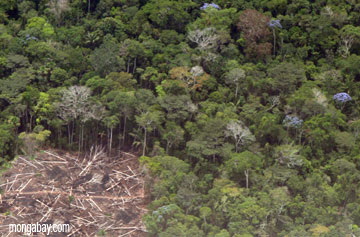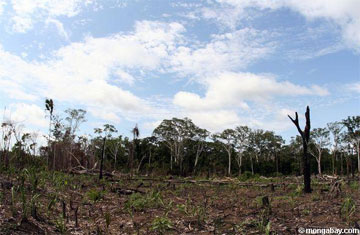Ancient Amazonian technology could save the world
Ancient Amazonian technology could save the world
mongabay.com
May 17, 2007
Terra preta, the ancient charcoal-based soil used by ancient Amazonians to create permanently fertile agricultural lands in the rainforest, is getting serious consideration as a means to fight global warming and meet domestic energy demand, reports an article in Scientific American.
The soil, easily distinguished from conventional Amazon earth by its black color and mineral richness, is thought to have been created by pre-Columbian people through a process of adding charcoal and animal bones to regular soil to create a highly fertile hybrid, ideal for agriculture.
Charcoal is the essential ingredient of terra preta, which gives the soil a more substantial quality as organic matter latches on to the compounds within it through oxidation, retaining moisture and nutrients. Despite these benefits, charcoal lacks substantial nutrients on its own, so Indians enriched the soil with organic waste like the bones of turtles, fish and birds, giving terra preta higher quantities of calcium, nitrogen, phosphorus and sulfur than typical earth. Further, when managed well, terra preta can avoid exhaustion from agricultural stress far longer than regular soil.
 Slash-and-burn in Peru. Photo by Rhett A. Butler. |
While the exact formula for re-creating terra preta was lost with the disappearance of Amazonians, soil scientists are looking at pyrolysis, a process in which biomass is burned at a high temperature in the absence of oxygen, as a means to produce agrichar, “a charcoal by-product that can be used as a fertilizer, and bio-oil, which is a mix of oxygenated hydrocarbons that can be used to generate heat or electricity,” writes Anne Casselman for Scientific American.
“Because the charcoal by-product, or ‘agrichar,’ does not readily break down, it could sequester for thousands of years nearly all the carbon it contains, rather than releasing it into the atmosphere as the greenhouse gas carbon dioxide. Along the way, it would boost agricultural productivity through its ability to retain nutrients and moisture,” she continues.
Casselman notes there are other benefits as well.
“There are other perks: Increasing production of bio-oil could decrease a country’s dependence on foreign oil. In the tropics, boosting soil productivity increases the number of growing seasons per year, which could help alleviate the pressure to deforest biodiversity hot spots. The new markets for agricultural crops, which would in effect become sources of fuel, could boost rural economies worldwide, just as the demand for ethanol has bolstered the price of corn,” she writes.
 Slash-and-burn in Peru. Photo by Rhett A. Butler. |
“The use of char also promises to combat marine dead zones, like that in the Gulf of Mexico caused by nitrogen- and phosphorus-rich agricultural runoff. Char reduces the need for man-made fertilizers by helping the soil retain nutrients. In addition, it can be made out of the very same manure and sewage that would otherwise pollute the oceans.”
Despite the potential of terra preta-like agrichar, there has been only limited interest it outside of economic circle. But this may soon change. Senator Ken Salazar, a Democrat from Colorado, is drafting a Senate bill on agrichar and may try to link it to the national Farm Bill, says Casselman.
“Inclusion in the Farm Bill would virtually guarantee subsidies for research and application of the agrichar process,” she notes.
Nevertheless, reports Casselman, some are skeptical that soil scientists will ever be able to replicate the terra preta.
“The secret of the terra preta is not only applying charcoal and chicken manure—there must be something else,” she quotes Bruno Glaser, a soil scientist at Bayreuth University in Germany, as saying. “You would need 50 or 100 years to get a similar combination between the stable charcoal and the ingredients.”
“I’m skeptical about adding just a pure carbon source,” Stanley Buol, a professor emeritus from the Department of Soil Science at North Carolina State University, told Casselman. “It will be black and look good,” but will it contain enough inorganic ions, such as phosphorus and nitrogen, essential to plant growth?”
Anne Casselman (2007) Inspired by Ancient Amazonians, a Plan to Convert Trash into Environmental Treasure (Scientific American May 15, 2007)
Related reading
Black Gold of the Amazon (Discover Magazine)
On August 13, 2005, American archaeologist James Petersen, Brazilian archaeologist Eduardo Neves, and two colleagues pulled up to a restaurant on a jungle road near Iranduba in the Brazilian Amazon to have a beer. At about 6:45 p.m., two young men, one brandishing a .38 revolver, entered the restaurant and demanded the patrons’ money. The archaeologists turned over their money and the bandits started to leave. Then, almost as an afterthought, one of them shot Petersen in the stomach. Neves and the others raced Petersen to the hospital, but their friend bled to death before they could reach help.
Pre-Columbian Amazon supported millions of people (mongabay.com)
Controversial evidence uncovered over the past decade suggests that the Amazon rainforest was once home to large sedentary populations of people. Besides the well-known empires of the Inca and their predecessors, the Huari, millions of people once lived in the forests and shaped the environment to suit their own needs.